The Illinois Soil Nitrogen Test is an innovative nitrogen test developed at the University of Illinois. This test measures a soil’s ability to slowly provide nitrogen to the crop during the growing season. The analysis looks at the organic portion of the soil, particularly at compounds called amino sugars, so the test has also been called the “Amino Sugar N Test”, or the “Organic N Test.”
Measuring the amino sugar parts of organic matter gives us an indication of potential release of nitrogen from the soil. Using values from this soil test and local calibration data from on-farm plots with similar cropping systems, we can predict the response for those areas of the field and create nitrogen prescriptions for each field. The prescription maps that are created using ISNT values can be used for several years because the test is measuring a property of the soil that changes slowly over time.
Cropsmith can help you get started using ISNT to learn more about the nitrogen mineralization capacity of the soils you farm, helping you get the most benefit for your nitrogen dollars. We often will be able to reduce your nitrogen bill. We can collect the samples, run the analysis and work with you on making recommendations for your fields. We can also set up and analyze response studies on your farm to better understand the benefits of variable rate nitrogen management with ISNT.


